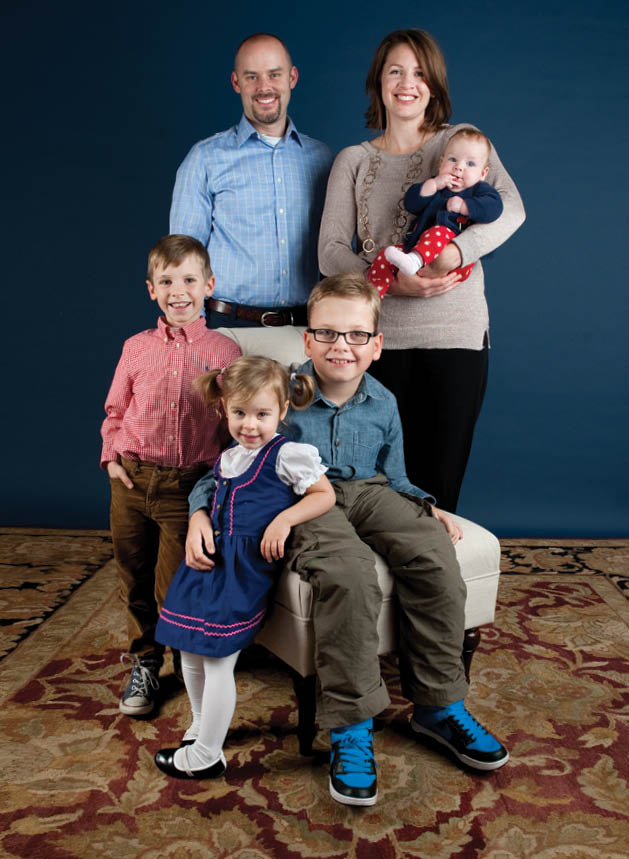Adoption might be one of the more poignant ways to tell the story of family—the sacrifice and unconditional love that comes with any family dynamic is perhaps magnified by the risk of loss that comes especially with an international adoption. This month we highlight the stories of three Plymouth families, but there are countless others bringing inspiration to our definitions of brother, father, mother, daughter.
The Larson Family
Noel and Paul Larson initially had no intention of adopting a special needs child from a far-off land. The Plymouth family was instead pursuing a domestic adoption from Bethany Christian Services of Minnesota. But once approved by the agency, they were handed a “Waiting Children” list, and in 2011 they found Darius, a then-7-year-old boy with cerebral palsy waiting for them in Lithuania.
“I was perusing the list and Darius’s biography stood out to me,” Noel Larson says. “I don’t know why. I showed it to Paul, and he was also moved. After some prayer we decided to switch gears and pursue him, because God had other plans for our family.”
Four years ago in March, the Larsons hopped on an airplane to Vilnius, the capital of the small Baltic nation of Lithuania, where they stayed for two and a half weeks while waiting for a judge to approve the adoption paperwork. They stayed in the old town and took in both the European- and Russian-influenced architecture. While there, they kept a blog, labasdarius.com.
On the trip’s second day they visited the orphanage and met Darius, as well as other children in need of families. “They rushed us and began grabbing at the gifts we had brought for him,” Noel Larson says. “Darius and the other children were especially enamored with Paul and his beard. They rarely interacted with men, so he was a novelty.”

The Larson family: Paul, Noel, Darius (10), Jack (7), Annika (3) and Vivian (6 mos). Photo by Emily J. Davis
All the Larsons knew of Darius’s past was that his mother gave him up for adoption while he was still a newborn in the hospital and she never saw him again; his biological father was never in the picture. The child’s somber past seemed a metaphor for Lithuania’s tragic 20th century history—the courthouse in which the adoption hearing took place had been a Nazi, and later a KGB, headquarters. The other half of the building is now a KGB museum.
Larson remembers having a difficult time explaining to the judge why they wanted to adopt a special needs child. Having been oppressed by the Communists for so many years, she concluded, Lithuanians struggled to understand why they would intentionally choose a more difficult path by adopting a child with special needs. Both 32, the Larsons were also one of the youngest couples adopting from Lithuania.
After they had custody of Darius, whom they pushed in a wheelchair, Vilnius’s narrow cobblestone streets lost their luster and became more difficult. “None of the buildings have ramps,” Larson says. “The mountains of ice piled on either side of the streets made using a wheelchair almost impossible. And Darius was stared at constantly. The people just weren’t used to seeing a child in a wheelchair.” Nevertheless, the Larsons explored the beautiful amber and linen shops along the Neris River and saw vendors selling painted eggs for the upcoming Easter holiday.
Bringing Darius home to Minnesota, while climactic for the Larsons, was no walk in the park for their new son. The most difficult part of being home wasn’t the language barrier or Darius’s disability—it was his transition from Lithuanian to American food. He cried during every meal for the first few weeks. The Larsons joke about it now, but it wasn’t funny then.
Today, Larson says, Darius is thriving. He’s in fourth grade and loves school. He loves watching the NFL and keeps track of statistics and game schedules.

Photo by Emily J. Davis
The Bauer Family
Last March, single mom Lois Bauer adopted Monique, now 18, who was born in Texas and originally adopted by a northern Minnesota family, but put back in foster care at age 15 after some changes in the family no longer made the adoption a good fit.
Bauer had served as legal guardian for another girl, who is now married and lives out of state. Recently she saw a highway billboard about Minnesota foster children who needed homes. “Hmmm, I should investigate this,” she thought to herself.
She met Monique on Saturday, May 10, 2013 on Mother’s Day weekend—a crisp day with a crystal clear blue sky. Monique was accompanied by her foster father. Bauer remembers that she dressed like a teenage model, wearing a letter jacket, black leggings and tall boots. “She had the biggest smile, and I remember my first words were ‘Oh my, you are adorable!’” Eventually, Monique gave her a box with a necklace in it engraved with the words “MOTHER DAUGHTER FRIENDS;” the teenager also grilled her new mother with many questions—her favorite color, whether she had animals, if she ever swore and whether she liked to travel.
Bauer and Monique played things safe for a time, avoiding moving too fast. After about five weeks, they both decided that the time was right to live under the same roof. “It made sense for her to do so at the beginning of the summer so she could adjust before the school year, her senior year, started,” Bauer says.
Move-in weekend was filled with Rubbermaid containers, suitcases and big smiles. Coincidentally, both mother and daughter wore blue and yellow. The adoption was complete nine months later—and negotiation of the space they share is an ongoing process, Bauer says.

Claudia and Bart Fletcher with Ben, 23, one of 12 children they have adopted. Photo by Emily J. Davis
The Fletcher Family
Claudia Fletcher is the Plymouth executive director of Bethany Christian Services and works frequently with adoption. But caring for children in need isn’t a subject she leaves at the office—Claudia and her husband Bart have 12 adopted children, ranging in age from 16 to 28. Their family has even grown to include five grandchildren.
On numerous occasions, the Fletchers have stepped up to the plate when a child in need came calling. For instance, in 2001 they were asked by a social worker to consider adopting a 9-year-old in Guatemala named Ben. On their trip to the impoverished Central American nation, they met 7-year-old Ricardo, and were able to adopt him a few years later.
Both trips to Guatemala were fairly short. The Fletchers enjoyed a more authentic experience on the first, visiting the colorful local market, staying at a bed and breakfast and spending time at the orphanage. Fletcher calls the second trip a “typical American experience” in that it was short and confined to a western hotel.
“The Guatemalan people are lovely and so is their country,” says Fletcher, who speaks Spanish and was able to converse with the locals. “The painful part was seeing the kids in the orphanage who had not yet found a home—and then the pain of hearing that the orphanage had closed when adoptions in Guatemala were stopped.”
The return to Minnesota had a few bumps in the road. For instance, on the flight home, Fletcher told Ben that he might not go back to Guatemala until he was grown up. He sobbed uncontrollably for a long time. Now, Ben is doing well. He graduated from high school and has a job working at Culver’s.
Meanwhile, international adoption was stopped five years ago in Guatemala, largely due to allegations that the practice had become a lucrative baby market.
“From the standpoint of older children, it is sad that international adoption has been closed,” Fletcher says. “I understand, though, why the government did what they did. There were so many babies being exported that they had to do something. While we were at the embassy, we saw thirty to forty babies there, and we were the only ones there with an older child.”
&
Guatemala Gone
Over the last decade, Guatemala became one of the most popular “sending countries” from which American families adopt children. The impoverished Central American nation was in many ways ideal for adoption, and by 2008, approximately 1 percent of all babies born in Guatemala were adopted by Americans. That’s because Guatemala boasted a largely privatized “notary” system, free of bureaucratic roadblocks and free of the requirement that the adopting family live in-country while the paperwork ran its course. But the proliferation of baby adoptions, the lucrative industry surrounding the practice, and allegations of corruption and baby theft ultimately prompted the Guatemalan government to stop international adoptions by 2010.
Writer Jacob Wheeler has written a book about Guatemalan adoption titled Between Light and Shadow, which both celebrates the rags-to-riches journey for thousands of adoptees and examines the degree to which it was a cold-hearted baby-selling industry.









